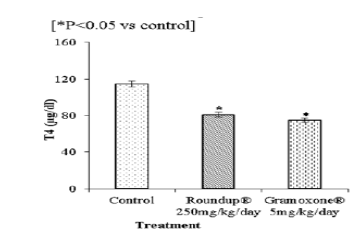


Indian Journal of Science and Technology
Year: 2021, Volume: 14, Issue: 24, Pages: 2034-2038
Original Article
Vaishali T Phusate1*
1Associate Professor, Department of Zoology, Ramnarain Ruia Autonomous College, Mumbai, 400019, India
*Corresponding Author
Email: [email protected]
Received Date:31 May 2021, Accepted Date:17 June 2021, Published Date:14 July 2021
Objectives: To study the effects of glyphosate based herbicide formulation Roundup® and paraquat based herbicide formulation Gramoxone® on the structure and function of the thyroid gland. Methods: Two groups of male rats were orally treated with a dosage of Roundup® (250 mg/kg) and Gramoxone® (5 mg/kg) respectively, from the 29th day of their age to 89th day. Control animals were administered with distilled water. At the end of the experimental period, blood samples and thyroid lobes were collected for estimation of thyroid hormones and histopathological changes, respectively. The function of the thyroid gland was evaluated by estimating thyroid hormones (thyroid stimulating hormone, thyroxine, and triiodothyronine) level, and the structure of the thyroid gland was assessed by observing histopathological changes. The treated group’s results were compared with the control group. Findings: Non-significant increase in thyroid stimulating hormone and a significant decrease in thyroxine and triiodothyronine levels, as well as moderate desquamation of cells into the follicular lumen and cellular infiltration in thyroid structure were observed. Results of this study provide evidence on histopathological changes in the thyroid gland along with the decrease in thyroxine and triiodothyronine levels on exposure to Roundup® and Gramoxone®. Roundup® is less thyrotoxic compared to Gramoxone®. Applications: Ignoring the guidelines of the Insecticide Boards and manufacturer’s instructions, Roundup® and Gramoxone® formulations are indiscriminately used for immediate weed killing. The human population is exposed to constituents of herbicide formulations through the air, water, and food. In this context, the result of the present study suggests that exposure to Roundup® and Gramoxone® formulations can be a risk to thyroid damage.
Keywords: Herbicide; Roundup®; Gramoxone®; Thyroid Hormones; Histopathology; thyrotoxic
© 2021 Phusate. This is an open-access article distributed under the terms of the Creative Commons Attribution License, which permits unrestricted use, distribution, and reproduction in any medium, provided the original author and source are credited. Published By Indian Society for Education and Environment (iSee)
Subscribe now for latest articles and news.